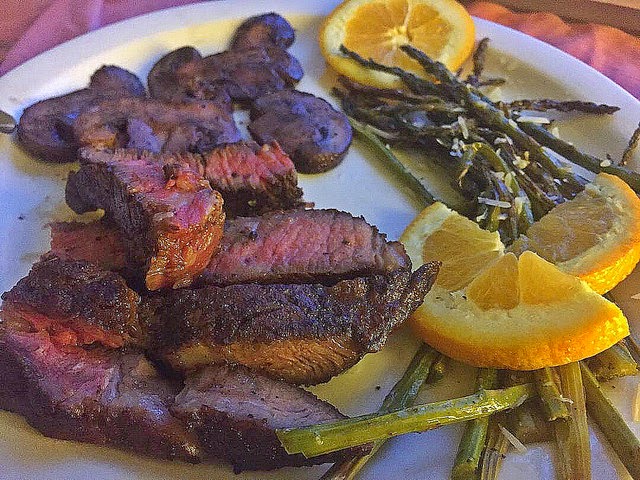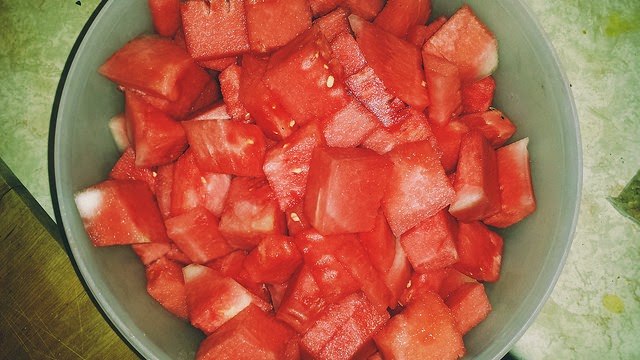Porterhouse 101
Unless you’re a vegetarian, I believe most people enjoy
steak and have an opinion on how it should be done. I’ve always liked the rich,
meaty flavor, but until I tasted a steak that my boyfriend, Scott, had cooked
for me, I had no idea what I’d been missing. I’ve savored many steaks that he
has prepared over the years, but I thought it was about time I learned his
secrets. He offered to help me in the kitchen, step-by-step, with a camera
handy to teach me the secret to super crazy wonderful melt-in-your-mouth steak.
I was all in.
First, we
bought a giant, beautiful Porterhouse steak from Snider Brothers Meats. I learned that a
Porterhouse is essentially the same thing as a T-bone, just quite a bit
thicker. It has two cuts of meat attached to the bone, thus making it the
perfect cut for a dinner for two. It was $19, and worth every penny. I’ve eaten
yummy steaks from the local grocery store, but if you want really extraordinary
taste it is essential that you purchase high quality meat from a specialized
butcher. It makes a huge difference. We had the butcher season it with their
blend at the counter and then brought it home to make magic.
Something
important to remember when cooking steak is to bring it to room temperature
before placing it on any heat source. Since our steak was so thick, I took it
out of the fridge and let it rest on the counter for 50 minutes. This ensures
that the steak will cook evenly and quickly. If you throw a fridge-cold steak
directly onto a hot pan or grill, the muscle fibers will seize up and the meat
will become tough. No beuno.
After
letting the steak come up to room temperature, we used a paring knife to cut
tiny slits in the top of the meat and filled them with minced garlic cloves.
This gives the steak a ton of delicious garlicky goodness. We also rubbed lots of salt and pepper on both
sides of the steak.
Next, he
put a big pat of butter into a really hot skillet with a bunch of dried sage
leaves to release the aromatics in the herb. We let that get nice and frothy. I
was mesmerized already. Something to note: if your butter turns a very dark
brown or black immediately, discard it and let the pan cool.
Once the
butter was melted and the pan was very, very hot (that’s important for a nice
sear) he added the steak into the skillet. The smell was out of this world. He
let it sear for a minute, and then started to baste the steak with the melted
butter in the pan using a small spoon. This is key for a rich, moist, decadent
flavor. He kept basting through the entire process, which was about three
minutes on each side.
After the
steak had been properly basted, we used a pair of tongs stand the steak up on
its side for a few seconds to render out the fat (see photo below). This helps
with taste and moisture.
We had a meat thermometer on hand
to tell us when the internal temperature had reached 125 degrees Fahrenheit
(ideal for medium-rare) but it wasn’t working! No worries—we did the ‘touch
test’, which tells you how done a protein is just by touching it, and that
saved the day. An excellent article that describes this in detail is here.
I think the
most crucial step in making an excellent steak is letting it rest after it
comes off the heat. I have cringed so many times watching perfectly cooked cuts
of meat get sliced while still hot off the grill and watching their juices run
out, leaving the entire filet dry and without flavor. It is such a crime! Any
meat needs to rest post-cooking for at least 10 minutes. This allows for the
juices to redistribute and settle back into the meat, making it juicy and
succulent.
Once the
meat had rested, we started to carve it away from the T-bone. The first to be
detached was each filet and then each side was cut into small sections on a
bias perpendicular to the bone. Cutting it this way (against the grain) ensures
a tender bite. Remember this: If you don’t cut the
fibers crosswise—regardless of the cut—you’ll be gnawing on longer, intact
muscle fibers. When you cut across the grain, your teeth don’t have to cut
across the grain, which leaves you with that “OMG THIS IS SO TENDER” feeling.
To
go alongside this scrumptious meat, we threw some white mushrooms into the same
skillet the steak had been basted in. Once they started to brown, we seasoned
them and added a generous splash of red wine. I was genuinely surprised at how
flavorful and meaty these mushrooms tasted…I will be using this method for
mushrooms as often as I can from here on out!
I
served the steak and mushrooms with asparagus that I had roasted in the oven
for 15 minutes at 400 degrees Fahrenheit with a little olive oil and salt and
pepper. Once it came out of the oven, I tossed it with Parmesan cheese and
lemon juice. Finally, I topped it with juicy orange slices. It was a perfect
pairing with the rich steak and mushrooms.
Porterhouse Steak with Red Wine Mushrooms and
Asparagus
Cook time: 20 minutes
Serves: 2
Ingredients:
1-1.5 lb Porterhouse steak
Salt & pepper
Olive oil
2 cloves garlic, sliced or minced
½ stick butter
6 sage leaves, fresh or dried
1 package button mushrooms (or any mushrooms you
like)
1 cup dry red wine such as Cabernet
1 bunch asparagus, trimmed
1 navel orange, sliced
Juice of 1 lemon
Handful Parmesan cheese
Allow meat to rest at
room temperature for 45-60 minutes prior to cooking.
· -Preheat oven to 400 degrees Fahrenheit.
· -Toss
asparagus with olive oil, salt and pepper and roast in the oven for 15 minutes.
· -Meanwhile, cut small
slits with a paring knife in the top of the steak and stuff with garlic. Rub
both sides with a generous amount of salt and pepper.
· -Place a skillet over
high heat and let butter melt. Add sage leaves and allow butter to froth. Be
careful not to burn the butter.
· -Once butter is melted
and frothy, add the steak and let sear approximately three minutes. Flip, and
let sear 2.5 minutes on the opposite side.
· -Using tongs, stand
the steak upright and sear the fatty edge directly onto the hot skillet for
10-20 seconds.
· -Remove steak from the
heat and allow to rest on a cutting board for a minimum of 10 minutes.
· -While the steak is
resting, throw the mushrooms into the same pan the steak was cooked in. Once
brown, season with salt and pepper. Then deglaze the pan with the red wine,
stir, let reduce for a couple minutes, and remove from heat.
· -Remove asparagus from
the oven and dress with lemon juice and Parmesan.
· -Cut the steak away
from the bone and cut against the grain. Serve with a side of mushrooms and
asparagus with sliced orange garnish.
Enjoy! As always, thank you for reading. Let me know if you make this steak and how much you love it! xoxo











Comments
Post a Comment